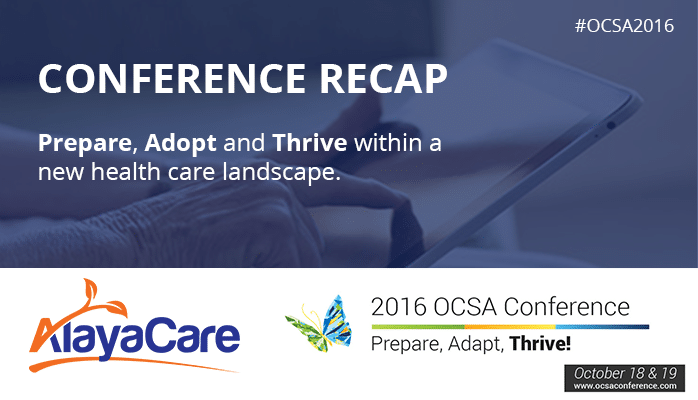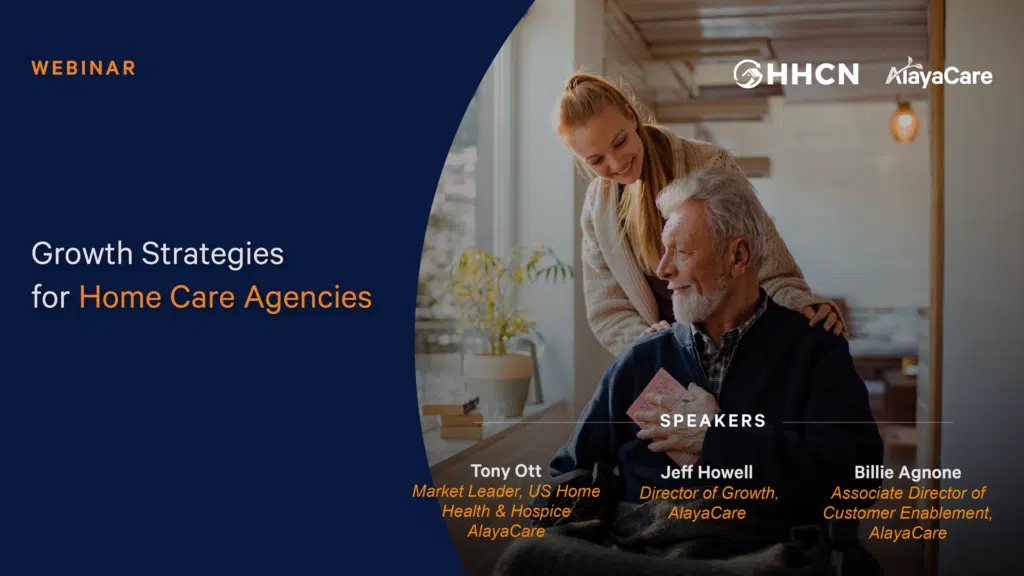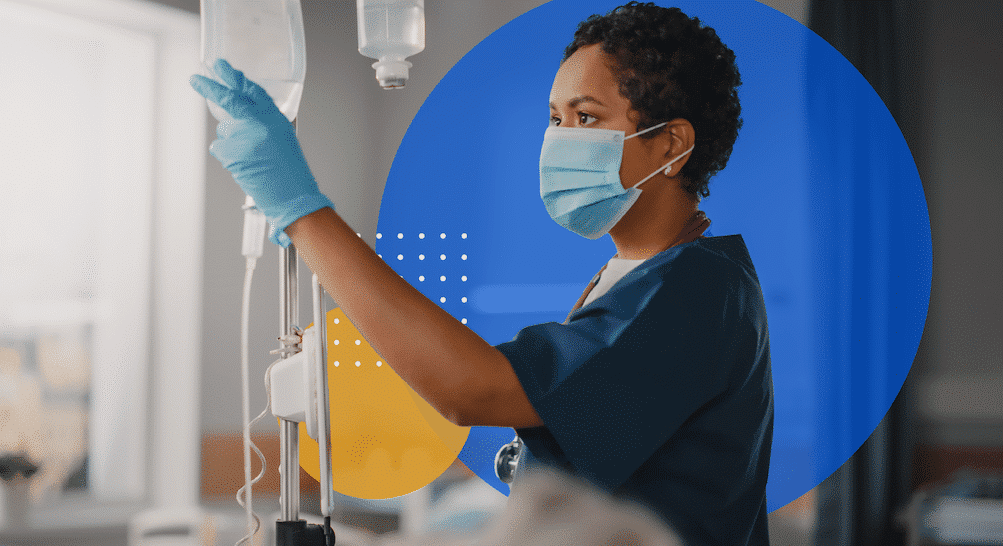Blog
OCSA 2016 Recap: Change is on the Horizon But Some Things Should Never Change

With the reintroduction of Bill 210, the Patients First Act, Ontario’s home and community care sector is preparing for system restructuring, new models of care coordination, greater integration between current system silos, strengthened accountability and improved consistency within the home and community care sector.
Therefore, it came as no surprise that the theme of the Ontario Community Support Association (OCSA) 2016 annual conference was reflected as “Prepare, Adapt, Thrive”. Held on October 18th, the OCSA conference brought together a wide range of professionals in the home and community care sector to share and discuss information surrounding industry reform. Here is a brief summary of the presentations focused on strategies for dealing with unprecedented change:
Opening Address
Initiating the conference was Debra Simon, CEO of OCSA, reminding the audience that despite impending changes, some things in health care haven’t and won’t change. The Community Support Services (CSS) sector continues to place patients first, focusing on the whole person and assisting clients and their families to receive care at home and avoid hospital admission. “Now it’s time for the rest of the health care system to catch up”, declared Simon. John Fraser,
MPP and Parliamentary Assistant to the Minister of Health, followed Simon by highlighting loneliness as one of the greatest undiagnosed conditions requiring support of the CSS sector. “The home and community care sector is poised to take its rightful place in the health care sector”, said Fraser, “to support clients to stay at home, to live independently, to achieve a sustainable health care and avoiding hospitalizations.”
Opening Keynote – Creating Peer to Peer Healthcare: Lessons in Storifying Evidence, Creativity, Nudge, and Healthy Viruses
With one of the most engaging conference starts, OCSA led with opening keynote Dr. Mike Evans, St. Michael’s hospital physician, Associate Professor of Family Medicine at University of Toronto, Lead Digital Preventive Medicine at Li Ka Shing Knowledge Institute, and CBC radio show host of Fresh Air. Dr. Evans also founded the Evans Health Lab that leverages highly talented creative people, clinicians, expert patients and best evidence to develop YouTube white boards with health messages that are truthful, powerful, funny and highly relevant. Check out “DocMikeEvans” whiteboard video on how to implement small changes to your week by making it harder (https://youtu.be/whPuRLil4c0).
In the Evans Lab, DocMike discovered that stories trump data and relationships trump stories. With this learning, he develops evidence-based health messages and embeds them in the stories of care.
According to DocMike, emerging in the sector is the use of “peer-to-peer healthcare” that entails capturing the wisdom of patients and having them share evidence-based health messaging and their experiences with family, friends, neighbours and communities. DocMike believes that with the rise of patient empowerment, the fact that two thirds of health care problems are managed at home, and the rise of seniors online, is leading to a change in how health care is delivered.
We are moving to a world where patients will be prescribed apps that measure biometrics and will trigger personalized evidence-based advice. This future state will combine technology, behavioural and personalized medicine. Similar to Debra Simon, DocMike reiterated that despite this evolution in health care delivery, one thing won’t change…the importance of relationships. DocMike ended his presentation by suggesting the audience get creative, make it suck less than what’s out there, and not prevent what we can’t do from what we can do.
Plenary Address – Levels of Care & CSS Agencies: What We Know and What Comes Next?
Dr. John Hirdes, Professor at the University of Waterloo and senior Canadian Fellow and Board Member of interRAI provided the plenary address, focusing on the implementation of the Level of Care Framework in Ontario used to ensure that people with the highest level of need are given high priority to receive the highest level of care.
This framework is intended to support the Patients First strategy by assuring equitable care, quality of service and greater confidence and trust in the home and community care sector through enhanced transparency and accountability.
Dr. Hirdes argued that the interRAI assessment should be used as a basis for discussion regarding client needs, clinical appropriateness of care, to communicate what can be expected from service providers and to engage with the client and family. Currently, the interRAI assessment results are not shared across the circle of care to and further, are not leveraged for population level and organization level improvements.
Dr. Hirdes presented the first analysis of Ontario’s interRAI-CHA data from 28,965 clients from 2013 to present. Some of the highlights included comparisons of the CSS sector with other health system sectors. Hirdes reported that more CSS clients are identified as having ADL impairment as compared to CCAC clients. CSS and Long-Term Care sector are comparable in their scores with regards to the CHESS score, whereas CSS has the lowest rates of aggressive behaviour compared to other sectors. The analysis also showed that the CSS sector contains the lowest percentage (30%) of clients in the low-mild category for priority level scores (MAPLe).
Despite this analysis, Hirdes also showed that CSS clients include 45% of clients who have unsteady gait, 25% have falls and more than 30% have shortness of breath, thereby supporting the need for CSS services as a critical component of the care plan.
Hirdes is currently developing a decision support tool to identify when Personal Support Workers services are most required.
Workshop – Leveraging Our Strengths: CSS Networks and the Collaborative Lead Agency Model
Exploring new integrated service delivery models to improve access to CSS services, Kathy Scanion, Executive Director of ONE CARE (South West LHIN) introduced the Huron and Perth CSS Network Collaborative Lead Agency Model. The model is intended to create a “one call, one go to person” team approach to provide support and services for clients to live at home. The collaborative has developed a common intake form and common client information package to ensure consistency of messaging. Furthermore, they have developed a central intake that is led by ONE CARE which receives all referrals from the CCAC and triages them to the most appropriate CSS provider. The central intake also provides coordination of care for patients requiring multiple services. A shared client record is currently being developed.
Scallion suggested that in developing this model, several lessons were learned. She suggested to the audience to go slow in order to go fast, to give up in order to gain, to work on consensus and set strong guiding principles, keeping the client as the central common good and to ensure that relationships rule followed by systematic processes. The Collaborative Lead Agency Model has been adopted by the SW LHIN for implementation across all subLHIN regions.
Workshop – Shared Perspectives on Enabling Patient Centred Care Using Technology
The final presentation of the day embodied the day’s key messages by exploring how technology can make things better while preserving client and employee relationships. Lori Holloway, CEO of Bellwoods Centres for Community Living and Brady Murphy, VP of Business Development at AlayaCare described how the organization has been burdened by a combination of manual and electronic systems. Holloway quickly realized that in order to expand services to meet community demand, something had to change. Bellwood’s Centres’ operations needed to become as efficient as possible. AlayaCare was the answer.
“It’s one of the most sophisticated platforms I’ve seen in a long time and AlayaCare’s knowledge of the sector is impressive,” asserted Holloway. The single most important benefit that software should have is to make our lives easier and to get out of your own way according to Holloway.
One of the key moments in the presentation occurred when a CSS provider in the audience asked, “So what makes AlayaCare so different and innovative for CSS providers?”
Murphy and Holloway addressed this question by identifying the following benefits that make AlayaCare the most innovative end-to-end home and community care solution on the market and preferred to none:
- A new Data Exploration tool, powered by Pentaho, provides AlayaCare customers with a suite of real-time data analytics and customizable reporting that is flexible and gives agencies control in mining and analyzing data without vendor involvement. With increased accountability requirements coming in Ontario, CSS agencies will have the data at their fingertips and be able to provide the analysis with a few clicks.
- A real-time configurable dashboard highlights the things agencies most need to be monitoring, enabling staff to be proactive in managing operations and client service.
- AlayaCare is developing an advanced logic for optimization of scheduling and matching of client to volunteer or provider that is second to none. This powerful technology will attempt thousands of schedule and match combinations per second to identify those options that accomplish a decrease in travel time, mileage, to optimize number of visits per week while maintaining client continuity of care.
- Distinct from many other solutions in the market, the AlayaCare modules work together with high degree of interoperability, enabling a fully seamless workflow all in one platform. Client files are linked to scheduled and to payroll.
- The AlayaCare platform is the most user friendly platform leveraging a modern user interface (as reported by current users).
- No other platform provides agencies with a Family Portal to enhance communication with clients and their families. The Family Portal is equipped with video conferencing capabilities and provides clients and agencies with tools they need to engage in the care of their loved ones.
If you missed this workshop, you can watch the video recording here.
For more information on the AlayaCare platform, please contact Brady Murphy, VP Business Development at [email protected].


